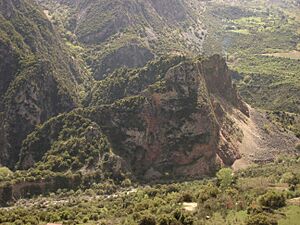Salmeniko Castle facts for kids
The Salmeniko Castle was an old castle found at the bottom of the Panachaiko mountain in Greece. It was also known as Orgia Castle or Oria Castle. This castle was very important because in 1461, it was the very last place held by the Byzantine Empire. It managed to hold out for eight years after the big city of Constantinople fell in 1453.
Contents
A Look Back at the Castle's History
How the Castle Was Built
The Salmeniko Castle was first built by local leaders called barons. These barons were part of the Latin Principality of Achaea. They built the castle sometime between the years 1280 and 1310. Over time, a large town grew up all around the castle.
The castle's location was naturally very strong. It sat on top of a hill, and behind the hill ran the Foinikas river. Because the cliffs on that side were so steep, no extra walls were needed there.
The Ottoman Attack
In 1460, the Ottoman Empire's leader, Sultan Mehmed II, attacked the area known as the Peloponnese. Many castles belonging to the Byzantine Despotate of Morea gave up easily. But Salmeniko was different. It was the very last place to fight back.
The castle was defended by a brave leader named Graitzas Palaiologos. The fortress held out for a whole year! The Ottoman army had big cannons, but they couldn't break down the strong castle walls.
How the Castle Fell
The Ottoman soldiers, called Janissaries, finally found a way to win. They discovered where the castle got its water and cut off the supply. After this, the town around the castle had to surrender.
There's a local story that says the people inside the castle tried to get water. They used sponges tied to ropes and lowered them down to the river below. But the Janissaries found out and cut their ropes.
According to a historian named Stefanos Thomopoulos, about 6,000 people from the town were taken as slaves. Also, 900 children were chosen to become part of the Devşirme. This was a system where Christian boys were taken to be trained as Ottoman soldiers.
Graitzas's Escape
Even after the town surrendered, Graitzas and some of his soldiers stayed in the castle's main part, called the citadel. Graitzas said he would give up the citadel only if his men could leave safely. Sultan Mehmed agreed to this.
Mehmed then left for another city, Aigio. He left a man named Hamouzas in charge to make sure Graitzas and his men left safely. But Hamouzas did not keep the promise. He arrested the first men who tried to leave the citadel.
When Sultan Mehmed heard about this, he replaced Hamouzas with another leader, Zaganos Pasha. Zaganos Pasha then started attacking the citadel again. Graitzas decided to try a daring escape. He and his men managed to break through the Ottoman lines. They found safety in a fortress called Lepanto, which was controlled by the Republic of Venice.
When Salmeniko Castle finally fell, it meant that almost all of the Peloponnese was now under Ottoman control. Only a few places still held by the Venetians, like Nafplion, Methoni, and Koroni, remained free.
What Remains Today
Today, the Salmeniko Castle and the old town are mostly ruins. But you can still see parts of them at the site. A medieval bridge from that time is still standing. There's also a place called the "Oria rock" nearby. Local stories say that a princess was killed there by a traitor during the Ottoman attack.
Sources
- Kostas Triandafyllou, Historic Dictionary of Patras, 3rd edition, Patras 1995
- Alexios Panagopoulos, Historic Dictionary of the Municipality of Rio, Achaia Prefecture, Peri Technon, Patras 2003 ISBN: 960-8260-32-9
- Stefanos Thomopoulos, History of the city of Patras, Patras 1999, Achaikes Publishers, Volume II
- Erineos Municipality


